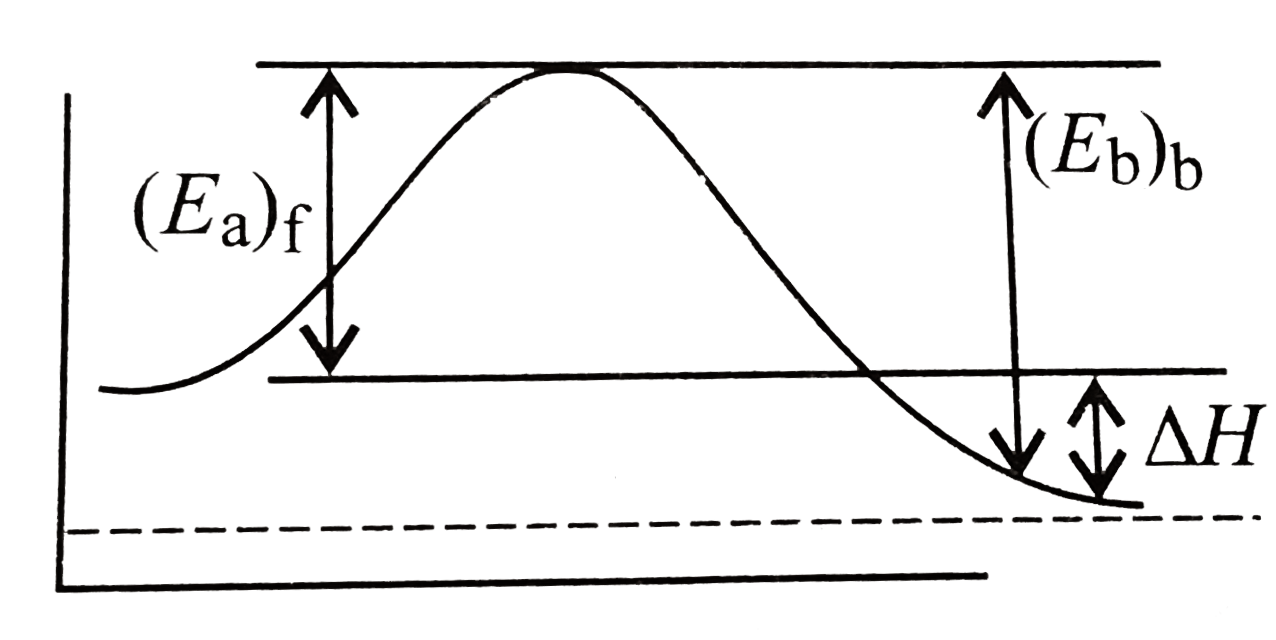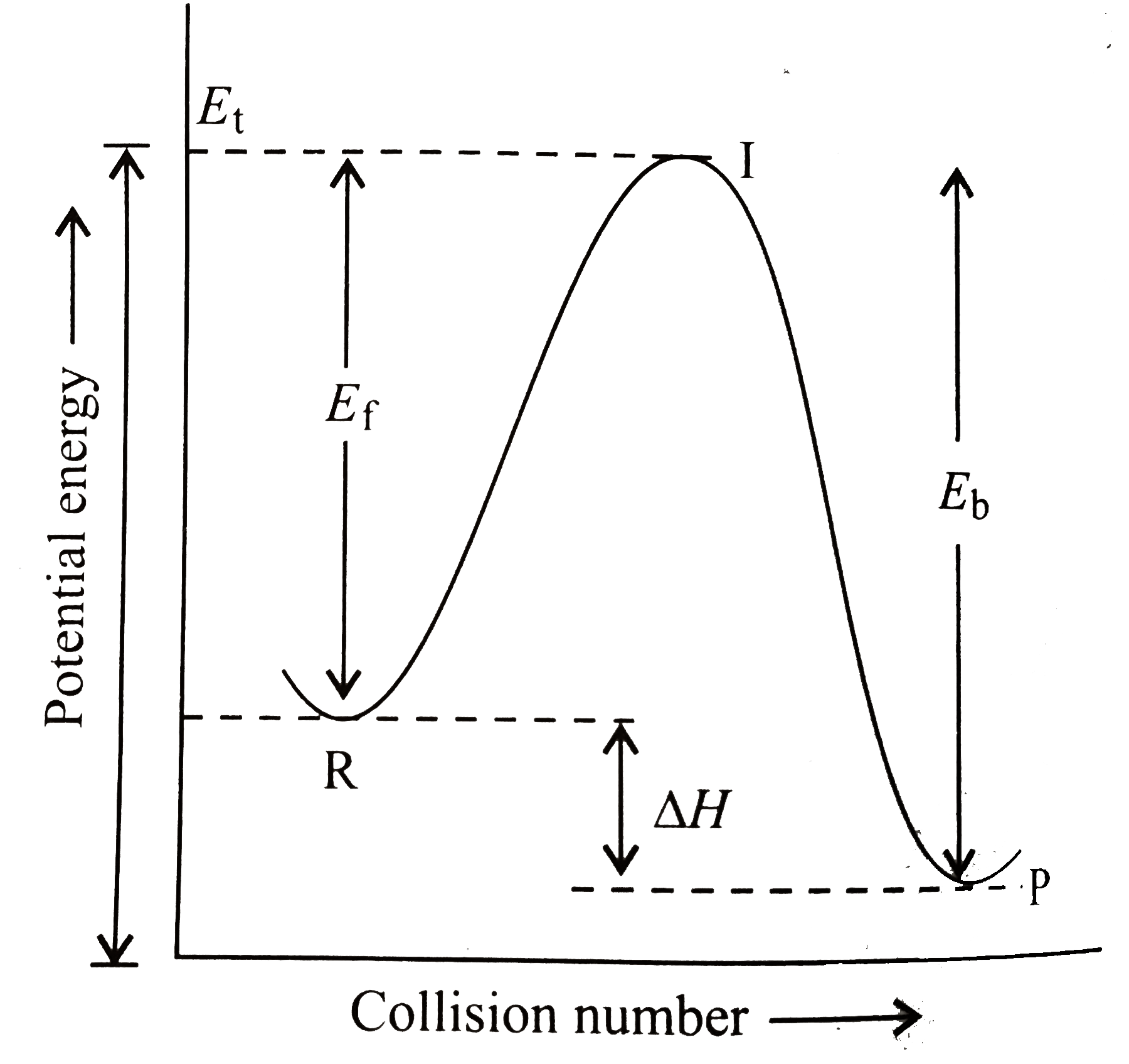The activation energy for the forward reaction X→Y is 60kJmol−1 and ΔH is −20kJmol−1. The activation energy for the reverse reaction is
40kJmol−1
60kJmol−1
80kJmol−1
20kJmol−1
The correct Answer is:C
To find the activation energy for the reverse reaction given the activation energy for the forward reaction and the enthalpy change (ΔH), we can follow these steps:
1. Identify Given Values:
- Activation energy for the forward reaction (Ea_forward) = 60 kJ/mol
- Enthalpy change (ΔH) = -20 kJ/mol
2. Understand the Relationship:
- For an exothermic reaction, the relationship between the activation energies of the forward and reverse reactions is given by:
Eareverse=Eaforward−ΔH
- Since ΔH is negative for exothermic reactions, we can rewrite this as:
Eareverse=Eaforward+|ΔH|
- Here, |ΔH| is the absolute value of ΔH.
3. Calculate the Absolute Value of ΔH:
- Since ΔH = -20 kJ/mol, the absolute value is:
|ΔH|=20 kJ/mol
4. Substitute the Values into the Formula:
- Now, substituting the known values into the equation:
Eareverse=60 kJ/mol+20 kJ/mol
5. Perform the Calculation:
- Adding the two values:
Eareverse=80 kJ/mol
6. Conclusion:
- The activation energy for the reverse reaction is 80 kJ/mol.
Final Answer:
The activation energy for the reverse reaction is 80 kJ/mol.
---
- Activation energy for the forward reaction (Ea_forward) = 60 kJ/mol
- Enthalpy change (ΔH) = -20 kJ/mol
- For an exothermic reaction, the relationship between the activation energies of the forward and reverse reactions is given by:
Eareverse=Eaforward−ΔH
- Since ΔH is negative for exothermic reactions, we can rewrite this as:
Eareverse=Eaforward+|ΔH|
- Here, |ΔH| is the absolute value of ΔH.
- Since ΔH = -20 kJ/mol, the absolute value is:
|ΔH|=20 kJ/mol
- Now, substituting the known values into the equation:
Eareverse=60 kJ/mol+20 kJ/mol
- Adding the two values:
Eareverse=80 kJ/mol
- The activation energy for the reverse reaction is 80 kJ/mol.
The activation energy for the reverse reaction is 80 kJ/mol.
Topper's Solved these Questions
- CHEMICAL KINETICSBOOK - CENGAGE CHEMISTRY ENGLISHCHAPTER - CHEMICAL KINETICSEXERCISE - Exercises Assertion-Reasoning
22 Videos
- CHEMICAL KINETICSBOOK - CENGAGE CHEMISTRY ENGLISHCHAPTER - CHEMICAL KINETICSEXERCISE - Exercises Integer
15 Videos
- CHEMICAL KINETICSBOOK - CENGAGE CHEMISTRY ENGLISHCHAPTER - CHEMICAL KINETICSEXERCISE - Exercises Multiple Correct
33 Videos
- CARBOXYLIC ACIDS AND THEIR DERIVATIVESBOOK - CENGAGE CHEMISTRY ENGLISHCHAPTER - CARBOXYLIC ACIDS AND THEIR DERIVATIVESEXERCISE - Exercises Archives (Analytical And Descriptive)
34 Videos
- COORDINATION COMPOUNDSBOOK - CENGAGE CHEMISTRY ENGLISHCHAPTER - COORDINATION COMPOUNDSEXERCISE - Archives Subjective
18 Videos
Similar Questions
The activation energy of exothermic reaction A→B is 80 kJ mol−1 . The heat of reaction is 200kJmol−1. The activation energy for the reactionB→a ( in kJ/mol) will be :
View SolutionIn an exothermic reaction X→Y, the activation energy is 100kJmol−1 of X. The enthalphy of the reaction is −140kJmol−1. The activation energy of the reverse reaction Y→X is

View SolutionIf a reaction A+B→C is exothermic to the extent of 30KJmol−1, the the forward reaction has an activation energy , 70KJmol−1, the activation energy for the reverse reaction is
View SolutionA colliison between reactant molecules must occur with a certain minimum energy before it is effective in yielding Product molecules. This minimum energy is called activation energy Ea Large the value of activation energy, smaller the value of rate constant k. Larger is the value of activation energy, greater is the effect of temperature rise on rate constant k.

Ef= Activation energy of forward reaction
Eb= Activation energy of backward reaction
ΔH=Ef−Eb
Ef= threshold energy
If a reaction A+B→C is exothermic to the extent 30kJmol−1 and the forward reaction has an activation energy of 249kJmol−1 the activation energy for reverse reaction in kJmol−1 is
View SolutionThe activation energy of a first order reaction at 300K is 60 kJmol−1. In the presence of a catalyst, the activation energy gets lowered to 50kJmol−1 at 300K. How many times the reaction rate change in the presence of a catalyst at the same temperature ?
View SolutionThe activation energy for a first order reaction is 60 kJ mol−1 in the absence of a catalyst and 50 kJ mol−1 in the presence of a catalyst. How many times will the rate of reaction grow in the presence of the catalyst if the reaction proceeds at 27∘C ?
View SolutionThe activation energy for a first order reaction is 60 kJ mol−1 in the absence of a catalyst and 50 kJ mol−1 in the presence of a catalyst. How many times will the rate of reaction grow in the presence of the catalyst if the reaction proceeds at 27∘C ?
View SolutionThe activation energy for a first order reaction is 60 kJ mol−1 in the absence of a catalyst and 50 kJ mol−1 in the presence of a catalyst. How many times will the rate of reaction grow in the presence of the catalyst if the reaction proceeds at 27∘C ?
View SolutionThe activation energy of a reaction is 75.2 kJ mol−1 in the absence of a catalyst and 50.14 kJ mol−1 with a catalyst. How many times will the rate of reaction grow in the presence of the catalyst if the reaction proceeds at 25∘C?[R=8.314JK−1 mole1 ]
View SolutionThe activation energy of a reaction is 75.2 kJ mol−1 in the absence of a catalyst and 50.14 kJ mol−1 with a catalyst. How many times will the rate of reaction grow in the presence of the catalyst if the reaction proceeds at 25∘C?[R=8.314JK−1 mole1 ]
View Solution